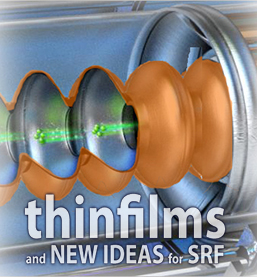Conveners
Beyond Nb: Alternate materials and mulilayer structures: 1
- Grigory Eremeev (Fermilab)
Beyond Nb: Alternate materials and mulilayer structures: 2
- Sebastian Keckert (Helmholtz-Zentrum Berlin)
Beyond Nb: Alternate materials and mulilayer structures: 3
- Mingqi Ge (Jefferson Lab)
Beyond Nb: Alternate materials and mulilayer structures: 4
- Marc Wenskat (DESY)
Due to the higher superconducting critical temperature (Tc ~18.3 K) and superheating field (Hsh ~400 mT) compared to Nb (Tc ~9.25 K, Hsh ~200 mT), Nb3Sn is a promising material as a surface coating on Nb superconductive radio frequency (SRF) cavities. Nb3Sn coated Nb cavities can deliver a higher quality factor and acceleration gradient when operated at 4 K replacing the bulk Nb SRF cavity...
Nb has been the material of choice for SRF cavities for many years now. However, because of its lower BCS resistance and increased critical temperature of 18.3 K, Nb3Sn has also been pushed as a potential candidate to allow the SRF community to surpass the performance of Nb. The feasibility of depositing Nb3Sn films onto Cu substrates using DC MS has previously been demonstrated at CERN. The...
Nb3Sn has great potential to be the next generation superconducting material on the inside of Cu superconducting radiofrequency cavities (SRF) due to its relatively high critical temperature Tc of 18 K compared to superconducting metals such as Nb, Tc = 9.2 K. This allows access to superconducting radiofrequency (SRF) cavities at operating conditions not possible for Nb, as well as better...
Nb3Sn promises better RF performance (higher Q and Eacc) than Nb at any given temperature because of superior superconducting properties. Since the Nb3Sn-coated cavities can operate at 4.3 K compared to 2 K for Nb, the demand for high-performing Nb3Sn-cavities is significantly growing for multiple accelerator applications. These cavities are produced routinely by growing a few microns thick...
Nb3Sn is a next-generation material for the SRF accelerator cavities to replace Nb, which promises superior performance and higher operating temperature than Nb because of higher critical temperature and superheating field, both twice compared to Nb. Accordingly, it promises significant cost reduction. The Sn vapor diffusion method is the most preferred and successful technique to coat niobium...
Nb3Sn on Nb thin films cavities by Tin Vapor Diffusion already show performance at 4.2 K comparable to Nb bulk cavities at 2 K, but a real breakthrough would be the use of copper as substrate, to enhance the thermal conductivity, opening up the possibility to cool down the cavity using cryocoolers instead of the more expensive helium bath.
Magnetron sputtering is the most studied technology...
V3Si is a types-II superconducting within the A-15 family of superconductors with a critical temperature (Tc) of 17K and a second critical field (HC2) of 24.2 T [1]. This means that an SRF cavities using V3Si rather than Nb would in theory be able to maintain a higher operating temperature and greater accelerator voltages. However, the material properties make bulk V3Si cavities impractical,...
The Mainz Energy-Recovering Superconducting Accelerator (MESA), an
energy-recovering (ER) LINAC, is currently under construction at the Institute
for Nuclear physics at the Johannes Gutenberg-Universit ̈at Mainz, Germany. In
the ER mode continues wave (CW) beam is accelerated from 5 MeV up to 105
MeV. The energy gain of the beam is provided through 2 ELBE-type cryomod-
ules containing two...
Nb3Sn, NbTiN and NbN are superconductors with a critical temperatures of 18.3, 12.6-17, 11.6-17.5 K, respectively, that are higher than that of Nb (9.3 K). Hence, at 4 K they have an RF resistance of an order of magni-tude lower than that of Nb, which leads to quality factors above those of Nb. In recent years, there has been an extensive effort converting Nb cavities into Nb3Sn by alloying...
Atomic layer deposition (ALD) is based on a sequence of self-limiting gas-solid surface reactions. It allows for conformal and smooth coating of highly structured, three-dimensional substrates without shadowing effect and with sub-nm thickness resolution, which makes it particularly interesting for coating the internal surface of SRF cavities. In particular, plasma-enhanced ALD (PEALD),...
Al2O3 is one of the potential insulator materials in the superconductor-insulator-superconductor (SIS) multilayer coatings of superconducting radio-frequency (SRF) cavities for pushing their performance limits.
We report on the successful coating of two 1.3 GHz Tesla- shaped SRF cavities with 18 nm and 36 nm layers of Al2O3 deposited by thermal atomic layer deposition (ALD). The coating...
Since its discovery at the beginning of the twentieth century, Superconductors have drown their paths into various fields from electromagnets with unprecedented magnetic fields to state of the art electronic circuits and radiofrequency cavities for particle accelerators. Despite the fact that they have enabled a real breakthrough in particular in the field of SRF cavities, Superconductors...
The proposed thin film-based multilayer structures in the form of superconductor-insulator-superconductor (SIS) may be the long-sought-after breakthrough for higher performance SRF cavities by enhancing both accelerating gradients and quality factors. In order to understand better the underlying mechanisms of SIS structures to be coated onto (S)RF cavities, we study sputtered S(I)S structures...
We have installed and commissioned a new furnace that can treat 1.3-GHz cavities for the studies on MgB2 coating. The coating method we will try first is based on the 2-step technique, i.e., coat B layer by flowing B2H6 gas in the first step, then react it with Mg vapor in the second step. We started to study the second step first, i.e., reaction of existing B samples from past projects...

